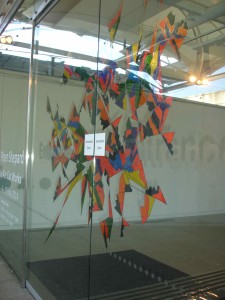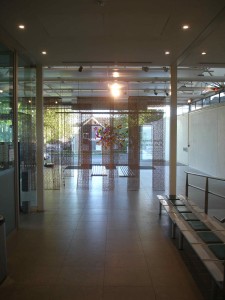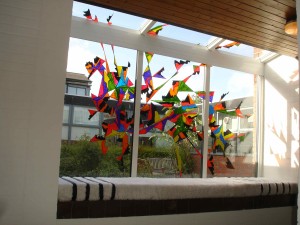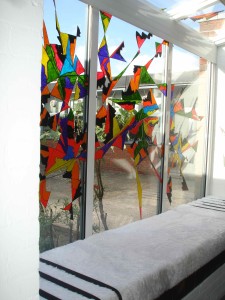From outside looking in.
I have presented a body of work comprised of 65 individual drawings created through the study of a card game called ‘Whist’. In accordance with Whist rules, the four players team up with the player sitting opposite them, but are not allowed to communicate their cards’ attributes to each other. On this basis they try to work together for a successful outcome, through the gradual presentation of the cards during the game play. The feelings experienced by the players primed by chance, through the shuffle and deal of the cards, and their decisions were recorded in the form of colours equating to Kandinsky’s colour theory. Cards, to me, are symbolic of characters and cultures within our global community and the feelings representative of life experience. Through applied transformation processes each feeling acquires a musical note, each player has a personal voice range, these combined create each drawings’ form and colours. The score for each ‘trick’ won within the game, is applied mathematically to determine the forms magnitude in relation to the other drawings presented.
The drawings have been placed together, ‘borderlinking’, and when
viewed appear as a whole design. There is no hierarchy implied as the varying magnitudes of the drawings disappear through the network of the drawn lines alluding to a supportive flexible grid. The overall shape for the design is determined through the characteristic of the individual drawing’s angles and colours, where the angles create thresholds for sharing feelings/colours, across borders. This also is referenced through the permission of the Fine Art exhibit placement sharing territory between the Film and Animation department and the Faculty. The surrounding architectural features of ‘stretcher bond’ brick walling and square grid-like placement of tiles in the flooring and seat area allude to the use of grids for the formation of the work, indicative of the institute support and creative tuition strategies. The window forming the transparent ground for the coloured nomadic drawings allows natural illumination by the varying intensities of sunlight, bright during the day akin to daily activity at UCA and dark during the night when the university is closed. The material chosen offers the aesthetic of stained glass used in the middle ages as a teaching tool for those in their communities who had not yet learnt to read often displayed in prestigious buildings.
The drawings cling to each other and the glass without the aid of adhesives allowing a type of voluntary bond alluding to that made through the psychological process of ‘fragilisation’ described by Bracha Ettinger’s Matrixial Theory, where subjects connect and share, relating in difference, leading the way toward a more understanding and peaceful way of living. Spectators are invited to sit and share in the aesthetic on the seat where the cushion cover carries the musical staves but also is made of textured fabric that may evoke infant memories of their ‘transitional object’ used when their subjectivity was on the brink of moving away from the Matrixial into the determinate structure of civilisation of today.
A View from the back of the gallery through the exhibits of the Piper Shepard Exhibition at University for the Creative Arts toward 52! design on entrance doors.
Exhibit resited proving material versitility.





